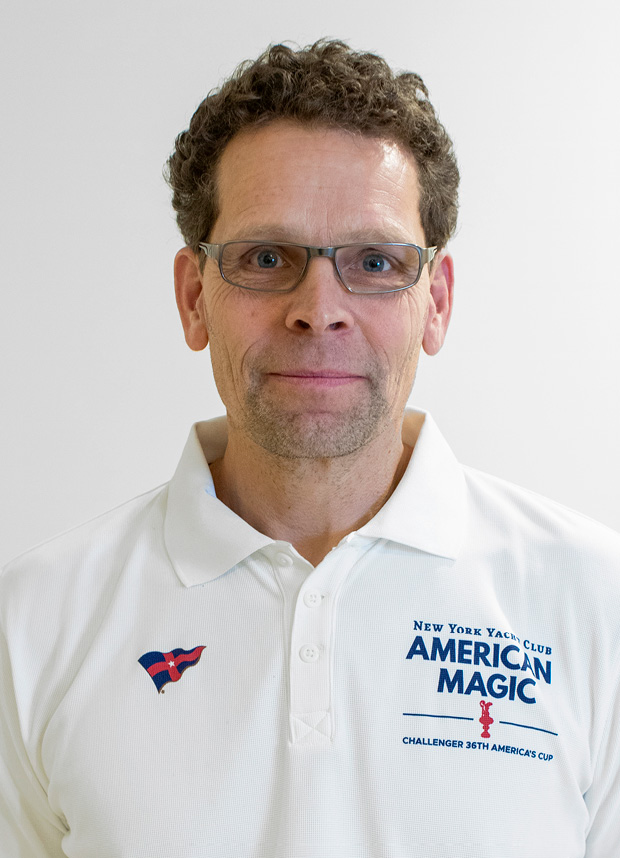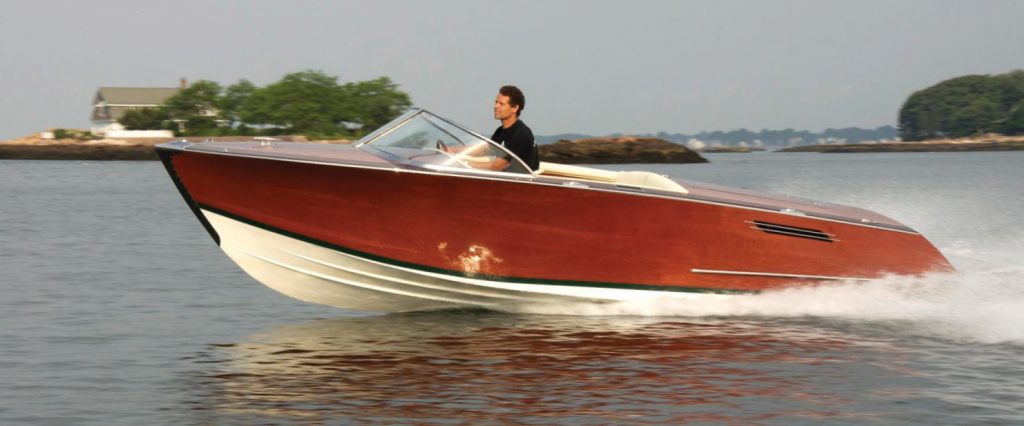
Ole Nielsen © Amory Ross/American Magic
Many WindCheck readers know Ole Nielsen as the founder and president of Destino Yachts in Branford, Connecticut, and the builder of the loveliest mahogany runabout we’ve ever seen. Our Editor-in-Chief interviewed Ole for the ‘On Watch’ page a few years ago, as the Destino 20 was nearing completion. Upon returning from the workshop he exclaimed, “It’s a nice as a Riva – possibly even nicer – and it’s handcrafted in the USA…wish I could afford it!” The Destino 20 was perhaps the most admired boat in the 2011 Newport International Boat Show, and the very deserving winner of the ‘Best New Powerboat’ award in the ‘Newport for New Products’ showcase.
About a year ago, Ole began a new chapter in his life. After closing Destino Yachts, he joined the production team at New York Yacht Club American Magic, bringing his considerable skills to their challenge for the 36th America’s Cup.
WindCheck: Where did you grow up, and how old were you when you started boating?
Ole Nielsen: I grew up in Denmark, but I didn’t start boating until I took a job at Dutch Wharf Boat Yard in Branford, Connecticut in 1999. That’s where it all began.
WC: How did you become interested in yacht design and boatbuilding?
ON: The more I worked with boats, the more I got interested in them – it kind of took hold of me. After restoring boats at Dutch Wharf, I wanted to get more into construction, and took a job for a composite boat builder in Connecticut for a few years. After that, I returned to Dutch Wharf for more wooden boat restoration, and they also had me be part of constructing a traditional mahogany runabout there. That’s when I really got interested in yacht design. While performing really well on a lake, that traditional boat had to wait for calm days on the Sound to be a real pleasure to use, and that’s when I said to myself, ‘I think I can improve on this.’ I signed up for the Westlawn School of Yacht Design and tore into it.
WC: What was the first boat you owned, and the first one you built?
ON: The first boat I owned, and still own, is the Destino 20 that I also designed. The first boat I built to completion was the runabout at Dutch Wharf. Before that, I built a bunch of strip-built canoes.
WC: How did Westlawn prepare you for launching Destino Yachts…and becoming an America’s Cup boatbuilder?
ON: Without Westlawn, I wouldn’t have been able to create a well-functioning boat as easily as I did. It’s a comprehensive and thorough course that gave me a much greater understanding of how boats are put together and why. It also gave me insight into all the different aspects of it from engineering, stability, motion through waves, how a boat planes, and more. As far as building America’s Cup boats, I think it’s incredible how high the level of engineering is on this project, and how precise the tolerances of everything is being kept. Every gram is accounted for, and we all work hard for those grams.
WC: What inspired you to apply for a job with American Magic?
ON: In June last year, I was working in the shed where The Mule was kept, before it was the Mule and was “just” a McConaghy 38. One day, someone from the American Magic team came to pick it up. I started asking questions, and that’s how I learned about the project. That whole thing festered in my head. I wanted to be part of it so badly. I talked about it with my wife, and she thought it was a good idea to pursue it, so I did, and now here I am.
WC: How many people are on the production team, and what is your primary role?
ON: I think we are around 30 to 35 boat builders on the team. I was hired as a production boat builder, but since I come from a different background than most of the guys, who are so incredibly talented at pre-preg, wet laminating and high-tech composite things, these are things I am learning. I find myself doing a lot of “special projects” too, which is very cool for me. I get to learn new things, and to apply all of my already-acquired skills as well.
WC: There’s probably no such thing as a ‘typical day in the shop’ for you and the other members of the production team, but please describe what you might expect to be doing tomorrow.
ON: As far as a typical day goes, I think if we are going to “bake” a part of the boat it means we need to partition off that part of the boat with insulating panels, install heaters and fans to circulate hot air around all parts to get them post-cured.

Master boatbuilder Ole (pictured here sea trialing the Destino 20 in the Thimble Islands) brings prodigious talent to New York Yacht Club American Magic.
WC: What makes Bristol, Rhode Island the best place in the world to construct a boat to win the America’s Cup?
ON: The heritage of Bristol is amazing, with the Herreshoff Marine Museum and America’s Cup Hall of Fame right down the street. More than that, everybody in the business is here. If you need something from the outside, chances are you can get it from somewhere between Bristol and Newport. Plenty of suppliers and industry professionals that are used to this level of boat building call this area home.
WC: Does building a ‘traditional’ wooden boat have anything in common with constructing a carbon fiber America’s Cup yacht? If so, please explain.
ON: Not much. I started laying my boat out with a laser; that part is the same. Some of the mold-making is quite similar, but other than that it’s really different.
WC: What do you like best about your job with American Magic?
ON: My work-mates, and seeing this project come together. I think it’s a marvel of engineering, and I can’t wait for it to be shared with the rest of the world. ■
Thank you very much Ole. We’re certain that your handiwork will play a big role in winning the Cup!
Special thanks to New York Yacht Club American Magic Communications Director Will Ricketson for facilitating this interview.




